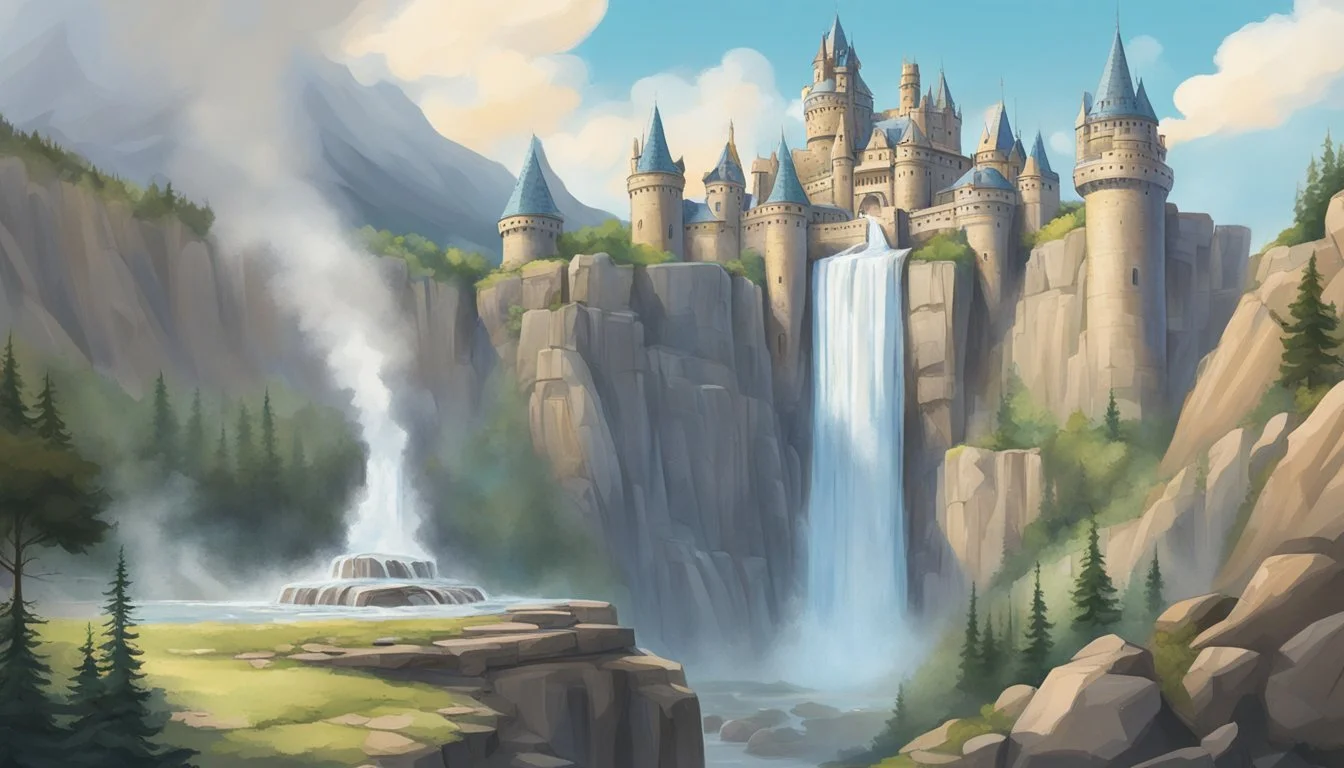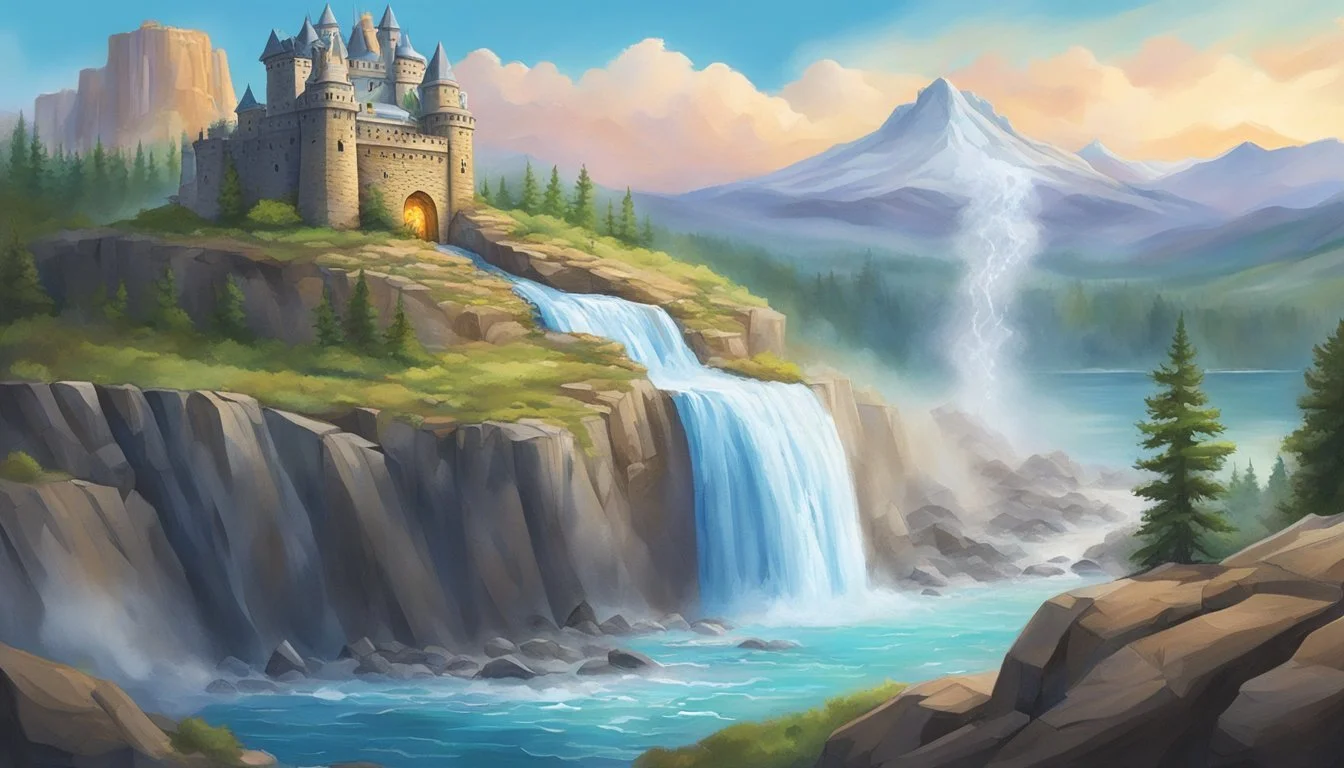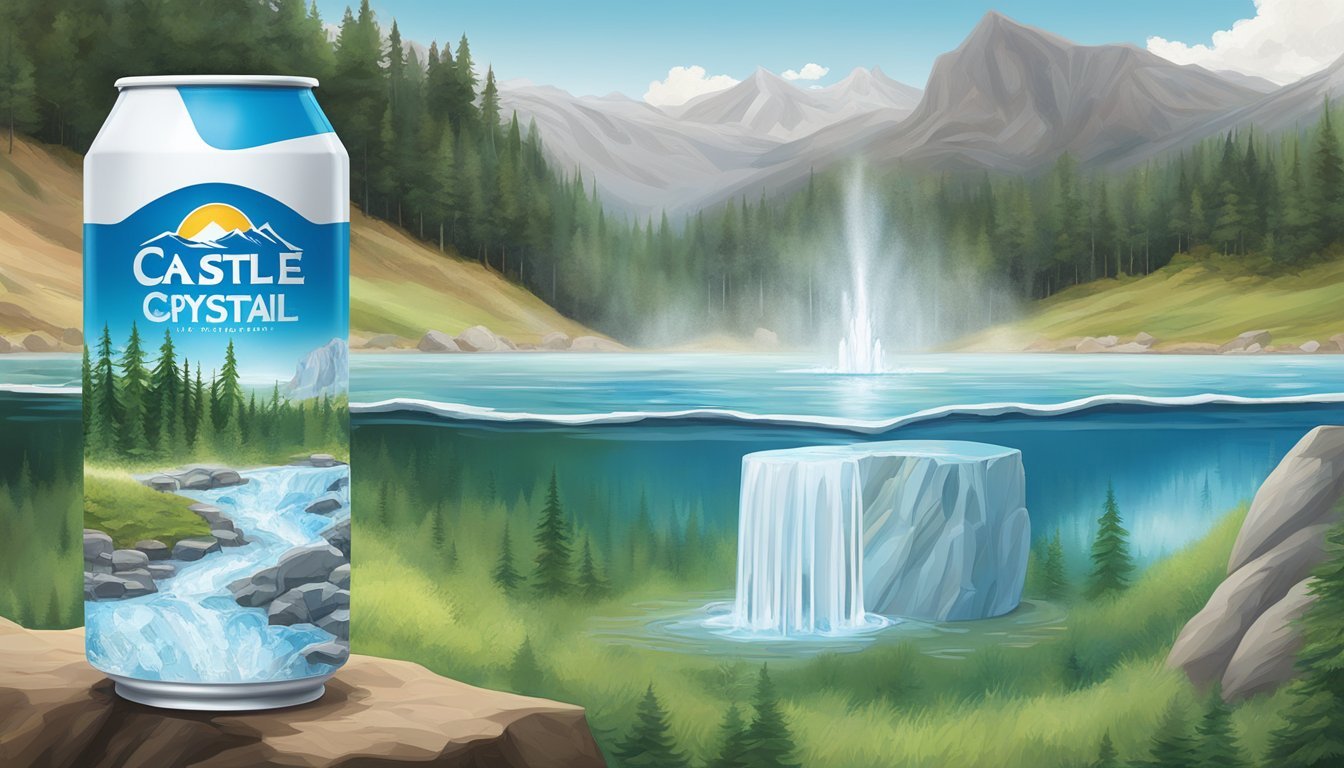Castle Rock vs. Crystal Geyser
The Ultimate Bottled Water Comparison
Choosing bottled water can seem like a simple task, but with so many brands on the market, it can be a bit overwhelming. Two popular choices are Castle Rock and Crystal Geyser, but which one stands out? Castle Rock is known for its crisp flavor, reminiscent of a fresh mountain hike, appealing to those seeking a refreshing and natural taste.
Crystal Geyser, on the other hand, offers a more straightforward experience. It may not be the most exciting option, but it provides a reliable and affordable choice for everyday hydration. It also boasts the claim of being "bottled at the source," although it is transported before bottling.
For those who prioritize flavor and a premium feel, Castle Rock might be the better option, whereas those looking for affordability and consistency might lean towards Crystal Geyser. Understanding these nuances can help consumers make an informed decision for their hydration needs.
Origin and History
Castle Rock and Crystal Geyser both claim distinct origins and histories that contribute significantly to their reputation in the market for natural spring water.
Origin of Castle Rock
Castle Rock Water is sourced from a natural spring nestled in the pristine Shasta-Trinity National Forest in Northern California. This source is renowned for its high elevation and the purity of its water, which is naturally filtered through miles of volcanic rock.
The company was founded with a mission to provide sustainably harvested spring water, maintaining an eco-friendly approach throughout its operations. Encouragingly, Castle Rock also places a strong emphasis on environmental conservation, ensuring that their practices do not disrupt the natural ecosystem of the Shasta region.
Origin of Crystal Geyser
Crystal Geyser natural alpine spring water originates from multiple natural springs located in the United States. One prominent source is the Olancha Peak in California. This area is characterized by its high-quality water, which is filtered naturally through granite formations, providing a crisp and clean taste.
Crystal Geyser has been bottling natural alpine spring water since 1977. It's important to note that it distinguishes itself by bottling at the source, which helps preserve the water's natural properties. Their commitment to using natural springs across various locations ensures that they maintain the highest standards for purity and freshness.
Water Source and Sustainability
Castle Rock and Crystal Geyser are two popular bottled water brands, each with distinct water sources and sustainability practices. This section discusses these aspects to help you make an informed choice.
Castle Rock Water Sources
Castle Rock sources its water from pristine springs in the Mount Shasta region of California. These springs are renowned for their high-quality, natural spring water. The water is naturally filtered through volcanic rock, enriching it with essential minerals. Castle Rock emphasizes maintaining the integrity and purity of its water source, ensuring consumers receive water that is as close to its natural state as possible.
Key Attributes:
Location: Mount Shasta, California
Type: Natural Spring Water
Filtration: Natural, through volcanic rock
Crystal Geyser Water Sources
Crystal Geyser sources its water from a variety of natural springs across the United States. Each bottling location is directly at the spring to ensure the water is bottled immediately after it is drawn. The company prides itself on bottling water that has no added minerals, maintaining its natural composition. Depending on the source, Crystal Geyser water may contain naturally occurring fluoride in small amounts, ranging from 0 to 0.7 parts per million.
Key Attributes:
Locations: Various natural springs across the U.S.
Type: Natural Spring Water
Fluoride Content: 0 to 0.7 parts per million
Sustainability Practices
Both brands have implemented sustainability practices, but they approach it differently. Castle Rock uses environmentally friendly packaging, including bottles made from recycled materials. They also employ water-saving measures in their bottling process and engage in conservation efforts to protect their water sources.
Crystal Geyser focuses on sustainable bottling at the source, which reduces the carbon footprint associated with transporting water. They use 100% recyclable PET plastic for their bottles and actively participate in various environmental partnerships.
Key Practices:
Castle Rock: Recycled materials, water-saving measures, conservation efforts
Crystal Geyser: Bottling at the source, 100% recyclable PET plastic, environmental partnerships
Production and Quality Standards
Understanding the production and quality standards of bottled water brands like Castle Rock and Crystal Geyser can help consumers make informed choices. Effective production processes and rigorous quality assurance are crucial for ensuring safe drinking water. Certifications from reputable organizations further validate the standards maintained by these brands.
Production Processes
Castle Rock sources its water from protected springs in Northern California. The water undergoes minimal processing to preserve its natural minerals. This ensures the water remains pure and retains its natural taste. The company employs environmentally friendly practices, including the use of sustainable packaging.
Crystal Geyser, on the other hand, sources its water from various springs across the United States, including Mount Shasta. The water is processed using advanced filtration systems. This process aims to remove impurities while maintaining the natural composition of the water.
Quality Assurance
Castle Rock adheres to stringent quality control measures. Regular testing is conducted to detect any contaminants, ensuring the water meets high safety standards. These tests are in line with both federal and state regulations.
Crystal Geyser also implements robust quality assurance protocols. The company performs frequent water quality tests, monitoring for harmful substances such as lead and bacteria. Both brands use modern laboratories for these tests, ensuring accurate and reliable results.
Certifications
Castle Rock is certified by the International Bottled Water Association (IBWA). This certification ensures compliance with strict standards regarding water quality and safety. It also highlights the brand's commitment to providing safe drinking water.
Crystal Geyser holds multiple certifications, including those from IBWA and Safe Drinking Water Act (SDWA) compliance. These certifications demonstrate the company's adherence to high standards of quality and safety, reassuring consumers of the water's purity and safety.
Castle Rock and Crystal Geyser both prioritize maintaining high-quality standards through effective production processes, quality assurance protocols, and reputable certifications. These efforts ensure that consumers receive safe and high-quality bottled water.
Health and Safety
Castle Rock and Crystal Geyser bottled water exhibit differences in health and safety aspects, particularly in terms of pH levels, mineral content, and contaminant testing results. Understanding these factors helps consumers make an informed choice about which brand to trust.
PH Levels
Castle Rock water typically registers a neutral to slightly alkaline pH level, falling within the range of 7.0 to 8.0. This range can be beneficial for those seeking to balance their body's pH levels.
On the other hand, Crystal Geyser water varies more, often testing slightly acidic to neutral, with pH readings between 6.5 and 7.5. It's essential to consider pH levels for those with sensitive stomachs or specific dietary needs.
Mineral Content
Castle Rock water sources are renowned for their rich mineral profiles. Common minerals found in Castle Rock water include calcium, magnesium, and potassium, which contribute to its taste and purported health benefits.
Crystal Geyser water, derived from various natural springs, also contains essential minerals but includes higher levels of sodium. The presence of sodium in bottled waters can be a concern for those monitoring their salt intake.
Contaminant Testing
Castle Rock water undergoes rigorous contaminant testing to ensure safety standards are met. Regular screening for harmful substances such as lead and chromium is conducted. These tests ensure that the water remains free from dangerous levels of contaminants.
Crystal Geyser has faced scrutiny from consumer watchdog organizations like the Environmental Working Group (EWG), raising concerns about transparency in their contaminant reporting. Despite this, Crystal Geyser commits to meeting federal safety guidelines for bottled water.
Close monitoring and independent testing are crucial to maintaining consumer trust in either brand.
Taste and Texture Profiles
When comparing Castle Rock and Crystal Geyser bottled waters, their taste and texture profiles stand out as significant factors. Both brands offer distinct experiences influenced by their sources and mineral content.
Castle Rock Taste Test
Castle Rock water is sourced from natural springs in the pristine wilderness, contributing to its clean and refreshing taste. The water is often described as crisp, with a smooth finish that lacks any harsh aftertaste.
Its texture is velvety, creating a pleasant mouthfeel. Essential minerals such as calcium and magnesium in Castle Rock water enhance the overall palatability, adding subtle, almost imperceptible notes that elevate the drinking experience.
This brand is favored by those who prefer a balanced and straightforward profile without overwhelming mineral flavors.
Crystal Geyser Taste Test
Crystal Geyser, sourced from multiple natural springs, offers a taste that varies slightly but is generally crisp and satisfying. The water is known for its clean and refreshing qualities, though some users report a noticeable but mild mineral taste.
The texture is smooth, contributing to a comfortable drinking experience. Essential minerals present in Crystal Geyser, such as potassium and sodium, add depth to its taste without overwhelming the palate.
This brand is a solid choice for those who enjoy water with a slight mineral presence but prefer it to be subtle and not overpowering.
Branding and Marketing
Castle Rock and Crystal Geyser leverage distinct branding and marketing strategies to capture consumer loyalty and market share. Both brands portray themselves uniquely in the marketplace, influencing consumer perception and sales.
Castle Rock's Brand Image
Castle Rock emphasizes a premium quality image through its marketing strategies. The brand highlights its water's source from natural springs located in pristine environments.
Castle Rock often incorporates imagery of mountains and clear streams in its advertising, which aligns with its emphasis on natural purity and a commitment to environmental sustainability.
Castle Rock positions itself as an ideal choice for health-conscious consumers seeking a high-quality, natural product. They also sponsor outdoor and wellness events to further cement their image as a brand aligned with a healthy and active lifestyle.
Crystal Geyser's Brand Image
Crystal Geyser focuses on affordability while still delivering a natural product. Its marketing highlights the water's natural sources but also emphasizes value, making it accessible to a broader consumer base.
Crystal Geyser employs straightforward branding that appeals to everyday consumers who value natural water but are also budget-conscious. The brand avoids overly luxurious imagery, choosing instead to focus on practical, reliable messaging.
Crystal Geyser is widely available across various retail channels, making it a convenient option for consumers. The brand's marketing often underscores its commitment to being a product that combines quality with affordability.
Consumer Perception
Consumers recognize Castle Rock for its commitment to environmental sustainability and premium quality. Those who buy Castle Rock often do so for its perceived health benefits and the brand's dedication to maintaining a pristine product.
Crystal Geyser is perceived as a reliable and affordable choice for everyday hydration. Consumers appreciate its balance of quality and cost. The brand’s accessibility and no-frills approach make it a popular option for both individual purchasers and families.
This mix of perceptions helps each brand carve out its unique niche in the competitive bottled water market, contributing to their respective customer bases and marketing success.
Packaging and Environmental Impact
The packaging choices and environmental efforts of bottled water brands like Castle Rock and Crystal Geyser significantly impact eco-conscious consumers. Key areas include materials used, recycling efforts, and eco-friendly initiatives each brand employs.
Packaging Materials
Castle Rock uses bottles made from 100% recyclable PET (Polyethylene Terephthalate) plastic, which is lightweight and shatter-resistant. PET is widely recognized for its convenience and relatively lower carbon footprint compared to other plastics.
Crystal Geyser also utilizes PET bottles, promoting their sturdiness and recyclability. Both brands ensure their packaging aligns with industry standards for safety and environmental impact.
Recycling Efforts
Castle Rock promotes comprehensive recycling programs. They have dedicated initiatives encouraging consumers to recycle their bottles properly. Information on the recyclable nature of their packaging is clearly indicated on the labels, making it simpler for consumers to comply.
Crystal Geyser actively supports recycling measures as well. They collaborate with local recycling programs to enhance the efficiency of reclaiming used bottles. Clear labeling of PET recyclability aids in the easy sorting of waste for recycling.
Eco-Friendly Initiatives
Castle Rock goes beyond recycling with initiatives aimed at reducing environmental impact. They source materials responsibly and invest in reducing the overall carbon footprint of their production and distribution processes.
Crystal Geyser balances their eco-friendly efforts with similar initiatives, such as minimizing resource usage and investing in renewable energy sources. They focus on continuous improvement of their environmental practices to ensure minimal impact.
Brand Packaging Material Recycling Efforts Eco-Friendly Initiatives Castle Rock 100% recyclable PET Promotes consumer recycling, clear labels Reducing carbon footprint, responsible sourcing Crystal Geyser 100% recyclable PET Collaborates with local programs, clear labels Minimizes resource usage, renewable energy
Price Point and Accessibility
Castle Rock and Crystal Geyser differ in their pricing and availability across states. Understanding these aspects helps consumers make informed choices.
Affordability Comparison
Castle Rock is often positioned as a premium brand with a higher price point. Consumers may find a 24-pack of 500ml bottles priced around $20 depending on the retailer. This cost reflects its branding as a high-quality spring water source.
Crystal Geyser, on the other hand, markets itself as an affordable option. A similar 24-pack of 500ml bottles typically costs between $8–$10. This makes it a more budget-friendly choice for everyday consumption without compromising on taste or water quality.
Availability in Different States
Castle Rock is selectively available and may be more commonly found in specialty stores or online platforms. Its limited distribution can make it harder to find in certain states. Consumers in regions where it is less common may have to rely on online ordering.
Crystal Geyser enjoys wider availability across the United States. It is commonly stocked in major supermarkets, convenience stores, and online. Its broad distribution network ensures that it is easily accessible, making it a convenient option for consumers in various states who are looking for an affordable, reliable bottled water.
Comparison with Other Brands
Castle Rock and Crystal Geyser are often compared with well-known bottled water brands such as Dasani, Aquafina, Fiji, Evian, and Smartwater in terms of taste, quality, and value.
Direct Competitors Analysis
Dasani and Aquafina are two popular brands known for their wide availability and affordability. Both are purified waters, often sourced from municipal supplies, then filtered using reverse osmosis.
Fiji and Evian cater to a premium market with natural spring water sources. Fiji features a distinct smooth taste due to its silica content, while Evian is known for its mineral-rich profile drawn from the French Alps.
Smartwater is another competitor, boasting vapor-distilled water with added electrolytes, offering a crisp and clean taste. Voss, with its stylish glass bottles, also targets the premium segment, emphasizing purity from an artesian source in Norway.
Essentia distinguishes itself with ionized and alkaline water, appealing to health-conscious consumers. Nestle Pure Life and Lifewtr are also significant market players, with Nestle offering purified water options and Lifewtr focusing on aesthetic packaging and added electrolytes.
Market Placement and Value Proposition
Castle Rock prides itself on its crisp flavor derived from natural spring sources, appealing to consumers who prioritize taste and environmental impact. It is positioned as a premium, sustainable option.
In contrast, Crystal Geyser markets itself as a more affordable natural spring water brand, making it accessible to a broader audience while maintaining quality.
Dasani and Aquafina dominate the mass-market sector with competitive pricing and wide distribution. Their purification processes ensure consistency in taste and safety. Meanwhile, Fiji and Evian attract consumers seeking luxury and unique mineral compositions.
Smartwater and Voss emphasize a combination of purity and modern packaging, catering to upscale demographics. Essentia's focus on alkalinity appeals to those interested in potential health benefits, while Nestle Pure Life and Lifewtr offer reliable options for everyday hydration needs.
Each brand leverages its unique selling points to capture its segment of the market, from cost-effective solutions to high-end, health-focused products.
Final Thoughts
Consumers are often faced with multiple choices when it comes to bottled water. Castle Rock and Crystal Geyser are two notable brands with distinct qualities.
Castle Rock prides itself on its natural spring sources from the pristine environments of Northern California. The brand emphasizes sustainability and transparency. Crystal Geyser, on the other hand, offers a consistently clean and crisp taste, sourced from various springs across the U.S.
A water sommelier might note that Castle Rock tends to have a minerally, slightly alkaline profile. Crystal Geyser offers a more neutral pH and subtle sweetness. Both have their own unique appeal depending on one's taste preferences.
From an investigative journalist's perspective, examining source transparency and corporate practices is crucial. Castle Rock is notable for its clear disclosure of water sources and commitment to environmentally friendly practices. Crystal Geyser has faced scrutiny in the past but maintains dedicated customer loyalty for its taste and availability.
Here are a few tips for choosing between these waters:
Read Labels: Check for information about the source.
Taste Test: Purchase small sizes to compare taste.
Environmental Impact: Consider the brand's sustainability practices.
In the end, both Castle Rock and Crystal Geyser offer quality bottled waters, appealing to different preferences and priorities among consumers.






